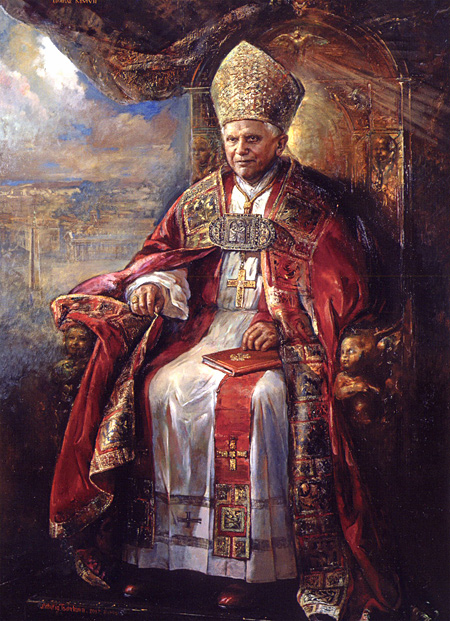Dear Friends and Benefactors,
The enthusiastic response to the Rosary Crusade we encounter throughout the world fills us with consolation and prompts us to take up this theme once again with you. If we are petitioning Heaven with this multitude of Aves, it is because the hour is indeed grave. We are sure of Our Lady’s victory because she herself foretold it, but the events that have been unfolding for nearly a century—since this triumph was announced at Fatima—oblige us to suppose that all kinds of other woes could yet befall mankind before this victory.
Yet the rules given at Fatima by the Mother of God were quite simple: if the world does not convert, it will be punished: “There will be a second war, more terrible than the first.” The world did not convert. And God’s answer was not long in coming. Since the Second World War, the world still has not converted. And if people think Russia has converted, they will have to explain to us in what it has converted, and to whom— economic liberalism?
Almost one hundred years later, we observe that the world has surely not become better; quite the contrary. The war of the unbelievers rages harder than ever, but it has taken an unexpected turn: the demolition of the Church is being carried out especially by subversion, by infiltrating the Church. Our holy Mother the Church is in the process of being transformed into a pile of spiritual ruins while the exterior façade remains more or less intact, thus deceiving the multitude about its real condition. And it has to be admitted that this subversion acquired an unexpected increase of efficacy on the occasion of the Second Vatican Council. It doesn’t take an advanced degree in theology to figure this out; today it is an historical fact.
What part of the responsibility should be attributed to the Council itself? This is a difficult question, but it is clear that this Council was not without effect, and its consequences have been well and truly disastrous. Because of it, the Church fell in step with the world. “We, too, in fact, we more than any others, honor mankind,” said Paul VI at the Council’s conclusion. And the man-centered orientation of Vatican II was harped on by John Paul II. But this orientation is indeed odd for the Church of God, supernatural in its essence, having received from Our Lord Jesus Christ not only its constitution and means, but first and foremost its end, which is nothing else than the continuation of His own redemptive and salvific mission: “Go into the whole world and preach the gospel to every creature. He who believes and is baptized shall be saved, but he who does not believe shall be condemned.” (Mk. 16:15-16).
And now, here is the tragedy: the divine mission of the Church has been replaced by a purely human one. It is a great mystery that leaves one astounded. Salvation now comes second, to say the least.
Few men—very few men, unfortunately—understand that the terrible crisis of the Church since the Second Vatican Council is a chastisement more terrible than any other, for this time the catastrophe is spiritual: what is wounded, what is noiselessly killed in the midst of an indifference worse than death, are souls. The loss of grace in a soul is the most terrible harm that can happen to it because it makes no noise, it is not felt. And the voice of the watchmen has fallen silent. The call to conversion, to penance, to the flight from sin, temptations and the world has given way, if not to indulgence, then at least to sympathy with the world. There is a real will to make peace with the modern world.
The mission of salvation has given way to a new sort of humanitarian mission; it is a matter of helping men of every condition and religion to live well together on earth.
There is no doubt that everything connected in the message of the Blessed Virgin of Fatima, what is referred to as the Secret of Fatima, has not yet come to an end. Certainly, what we are living is per force part and parcel of the events that will end one day, eventually, with the triumph of Mary. What will happen? How will we recognize it? In any case, it will at least entail the conversion of Russia according to the very words of the Blessed Virgin Mary.
In 1917 at Rome, the foes of God were celebrating the 200th anniversary of Freemasonry and the 400th anniversary of Protestantism with parades of special violence against the Holy See. The demonstrators boisterously proclaimed the reign of Satan over the Vatican and the Sovereign Pontiff. Maximilian Kolbe, still a seminarian, witnessed these painful events and said:
This mortal hatred of the Church, of Christ, and of His Vicar on earth is not just an outburst of misguided individuals, but rather a systematic action that proceeds from the principle of Freemasonry: the destruction of all religion, but especially the Catholic religion. [Pisma Ojca Maksymiliana Marii Kolbego franciszkanina, Niepokalanow, maszynopsis, 1970; English tr. from The Immaculata Our Ideal, by Fr. Karl Stehlin (Warsaw, 2005), p. 39]….
Is it possible that our enemies should deploy so much activity so as to attain superiority while we stay idle, or at best apply ourselves to prayer without getting to work? Might we not have more powerful arms—the protection of Heaven and of the Immaculate Virgin? The Immaculata, victorious and triumphant over all heresies, will not yield to the advancing enemy if she finds faithful servants obedient to her command: she will bring off new victories even greater than can be imagined. We have to put ourselves like docile instruments into her hands, employing all lawful means, getting the word out everywhere by the diffusion of the Marian press and the Miraculous Medal, and enhancing our action by prayer and good example. [Testimony of Fr. Pignalberi reported during the process of canonization].
He founded the Militia of the Immaculata just a few days after the October 13th apparition of Our Lady at Fatima, when the great miracle of the sun took place. It was in fact on October 16, with six fellow seminarians, that he consecrated himself to the Immaculate Heart of Mary for the purpose of leading the whole world to God by the Immaculata.
One cannot but be struck by the affinity between the message of Fatima and the response of the Polish Franciscan while reading his act of consecration:
O Immaculata, Queen of heaven and earth, Refuge of sinners, our most loving Mother, to whom God deigned to entrust the entire order of mercy, behold I, N., an unworthy sinner, cast myself at Thy feet and humbly ask Thee to deign to accept me completely and utterly as Thy property and possession; and do with me as it pleases Thee: all the faculties of my soul and body, my entire life, my death and my eternity. Dispose of me as Thou willst, so that what has been said of Thee might be fulfilled: ‘She will crush the head of the serpent,’ and also, ‘Thou alone hast vanquished all heresies throughout the world.’ Make of me an instrument in Thy immaculate and merciful hands, which serves Thee, in order to increase reverence for Thee as much as possible in so many fallen-away and lukewarm souls. Thus the benevolent reign of the Sacred Heart of Jesus will spread more and more. For whatever place Thou enters, Thou shalt implore upon it the grace of conversion an d sanctification, for all graces come to us from the Sacred Heart of Jesus only through Thy hands. [Scritti di Massimiliano Kolbe, new ed. (Rome: ENMI, 1997), Vol. I; Eng. version, The Immaculata Our Ideal]
Very dear faithful, it is in this same spirit that we launched the Rosary Crusade. But prayer is only a part of it: let us not forget the other two very important elements, penance and devotion to the Immaculate Heart of Mary. By mortification, we wish to make reparation for the insults given to Mary, and in union with her sorrowful Heart we wish to associate ourselves as closely as possible to the sacrifice of the Cross of our Lord, because by it our salvation is effected. Thus we are at the heart of the message of Fatima: “God wishes to introduce devotion to my Immaculate Heart.” Perhaps not enough emphasis is given to this aspect, which seems to us even more important than the consecration of Russia and which is the second condition indicated by Mary to the pope for her triumph: consecrate Russia and promote devotion to her Immaculate Heart.
In this month of October we are going to enter into a new phase in our relations with the Vatican, that of the doctrinal discussions. What is at stake is very important, and we recommend them to your prayers. Undoubtedly that also is a part of our Crusade, and obviously this intention is included in the triumph of the Immaculate Heart of Mary we all desire. That also completely outstrips all our own powers, and it would be folly pure and simple to undertake such an enterprise were it not sustained by the power of the supernatural means such as prayer and penance.
We do not want to conclude this letter without also thanking you for your generosity, which enables our work to develop throughout the world. There is one thing, though, that slows us down: the harvest is abundant, but workers for the harvest are lacking. Our Lord has already said it and has shown the remedy: pray for vocations! How we should like to come to the aid of all the faithful who only have the Mass once a month, or only on Sundays, unable to benefit from normal pastoral care… Yet the good Lord has gratified us this year with 27 new priests, and we expect an even slightly larger number next year. But even that is not enough, so great is the demand worldwide.
You are deeply thanked for all your efforts. May God reward you with the abundant graces and blessings we implore on you all, your families, your children. May Our Lady of the Rosary, the Immaculate Heart of Mary, protect you.
On the Feast of the Maternity of the Blessed Virgin Mary, October 11, 2009.
+ Bernard Fellay
Superior General













